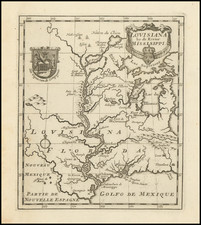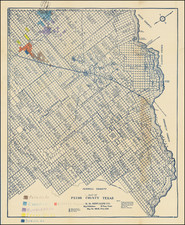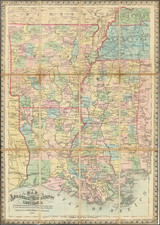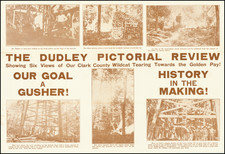This map illustrates the proposed portion of the Intercoastal Canal along the Gulf of Mexico, spanning from Texas to Louisiana. It highlights the route of the canal with segments that are currently navigable (marked in blue) and sections that require dredging (marked in red). Significant cities such as Houston, Galveston, Corpus Christi, and New Orleans are marked along with important waterways and geographic features like the Sabine Pass, Galveston Bay, and the Brazos River. The map is based upon an example of the map which appeared in The Galveston Daily News by John H. Morgan.
History of the Intracoastal Waterway in Texas and Louisiana
The Intracoastal Waterway (ICW) is a 3,000-mile inland waterway along the Atlantic and Gulf coasts of the United States, extending from Massachusetts to Brownsville, Texas. It includes natural inlets, saltwater rivers, bays, sounds, and artificial canals, providing a safe navigable route along its length without many hazards of open sea travel.
The grand concept of a coastal canal system that would eventually connect Boston Harbor with Brownsville Harbor was introduced by Albert Gallatin, the United States Secretary of the Treasury, in an 1808 report on Public Roads and Canals. By 1819, Secretary of War John C. Calhoun published his Report on Roads and Canals, emphasizing the urgent need for an improved internal transportation system including waterways. Calhoun proposed that the Army Corps of Engineers develop and supervise construction of these internal improvements, recognizing that individual states would struggle to finance and construct a national system without federal assistance. The General Survey Agency of 1824 represented the first step in this prolonged effort. By 1829, much of the route along the eastern portion of the proposed intracoastal waterway had been selected. Congress authorized several surveys for a canal across Florida to connect the Atlantic Ocean and the Gulf of Mexico. However, construction was delayed due to pressing domestic and military concerns.
In 1873, Congress authorized a survey for a system to connect inland waters from Donaldsonville, Louisiana, to the Rio Grande, and by 1875 the Army engineers had submitted the first plan for a waterway east of the Mississippi.
The railroads fiercely resisted the development of waterways, employing techniques to hamper waterborne competition, such as hauling materials at a loss and refusing to transship goods that could be carried by both methods. Wars, railroad competition, and the magnitude of the task slowed progress on the intracoastal waterway until after World War II.
The state of Texas had already dredged a shallow channel through part of the West Bay inside Galveston Island. In 1892, Congress authorized the enlargement and extension of that channel to Christmas Point in Oyster Bay. In 1897, Congress authorized the purchase of an eleven-mile canal from the Brazos Navigation Company, completed in 1902.
The discovery of oil and the development of the Spindletop oilfield near Beaumont provided a major impetus for further canal development. In 1905, the Rivers and Harbors Act authorized a second major survey of inland waterways. The subsequent growth of the oil and petrochemical industries along the Texas coast produced a demand for cheap transportation of bulk materials.
Rarity
This is the first time we have seen the map.









![[Early Texas Aeronautical Navigation Map] Aeronautical Map For Cross Country . . Drawn by Cpl. V.G. Smylie Aero Squadron, Ellington Field](https://storage.googleapis.com/raremaps/img/small/59678.jpg)



![(Texas) Denkschrift über eine Reise nach Nord-Mexiko, verbunden mit der Expedition des Obersten Donniphan, in den Jahren 1846 und 1847. Von Dr. A. Wislizenus. Aus dem Englischen übertragen von George M. von Ross. Mit einem wiffenschaftlichen Anhange und drei Karten. [Description of a voyage to northern Mexico connected with Colonel Doniphan's expedition in 1846 and 1847 By Dr. A. Wislizenus. Translated from the English by George M. von Ross. With a scholarly appendix and three maps.]](https://storage.googleapis.com/raremaps/img/small/88574.jpg)
